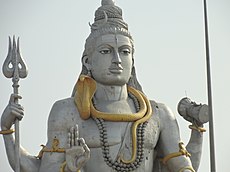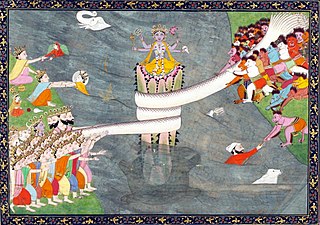Vasuki
| Vasuki | |
|---|---|
King of the Serpents[1] | |
 Vasuki depicted around the neck of Shiva in Karnataka. | |
| Venerated in | Shaivism |
| Affiliation | Naga |
| Abode | Kailasha |
| Symbols | Nagamani |
| Genealogy | |
| Parents | Kadru (mother), Kashyapa (father) |
| Siblings | Manasa, Shesha |
| Consort | Shatashirsha[2] |
| Children | Ananta,Aryaka and 1 unnamed daughter |
Vasuki (Sanskrit: वासुकि, romanized: Vāsuki) is the king of the nagas in Hinduism. He is described as having a gem called Nagamani (serpent's ornament) on his head. Shesha, another king of the nagas and the bed on which Vishnu rests, is his elder brother,[3] and Manasa, another naga, is his sister. In Hindu iconography, he is generally depicted coiling around the neck of Shiva, who is believed to have blessed and worn him as an ornament.
He is known in Chinese and Japanese mythology as being one of the "eight Great Dragon Kings" (八大龍王 pinyin: Bādà lóngwáng; Japanese: Hachidai Ryūō),[4] amongst Nanda (Nāgarāja), Upananda, Sāgara (Shakara), Takshaka, Balavan, Anavatapta, and Utpala.
Legend
[edit]Vasuki is one of the sons of the sage Kashyapa and Kadru.[5]
He is accorded a significant role in the legend of Samudra Manthana. He is described to have allowed both the devas and the asuras to bind him to Mount Mandara, so that they could use him as their churning rope to extract the amrita from the Ocean of Milk.[6]

In the Mahabharata, Vasuki is stated to have been cursed by Kadru. He refused to aid her in her scheme of hanging to the tail of the divine horse Ucchaishshravas with his other siblings to cause it to appear black, so that she could cheat in her wager against her sister Vinata. Condemned to burn with numerous brothers in King Janamejaya's snake sacrifice, he sought refuge with the devas, participating in the churning of the ocean.[7]
Having retreated to the netherworld, but wishing to save his brothers from the snake sacrifice, Vasuki sought the counsel of his siblings. One of them, Elapatra, stated that he had overheard Brahma informing the other deities that the son born to their sister named Jaratkaru and a sage who shared the same name would be their saviour. Vasuki made the arrangements to marry his sister to the sage. The son born to them, Astika, was able to successfully put an end to Janamejaya's persecution of the nagas.[8]
Buddhism
[edit]In the Buddhist religion, Vasuki and the other Naga Kings appear in the audience for many of Gautama Buddha's sermons. The duties of the naga Kings included leading the nagas in protecting and worshipping the Buddha, as well as protecting other enlightened beings. Vasuki's naga priest is Tatig Naga.[citation needed]
Veneration
[edit]The Vāsuka/Vāsuca temple is located near Haripad, Mannarasala Illom in Kerala and the Visakha district in Andhra Pradesh. According to the regional legend of the Kukke Subramanya temple in Karnataka, the deity Kartikeya is regarded to have offered protection to Vasuki from the attack of Garuda, the mount of Vishnu.[9]
See also
[edit]Sayings
[edit]Vasuki Naga is a prominent figure in Hindu mythology, often associated with Lord Shiva and various mythological stories. Some common sayings or attributes associated with Vasuki Naga include:
1. King of Snakes: Vasuki Naga is often referred to as the king of snakes due to his prominent role in various mythological narratives.
2. Adorned by Lord Shiva: In many stories, Vasuki Naga is depicted as adorning Lord Shiva, especially as a necklace or garland.
3. Symbol of Power and Protection: Vasuki is considered a symbol of power and protection, often invoked for blessings and safety against negative forces.
4. Immortality: As a divine being, Vasuki Naga is often associated with immortality or eternal life, symbolizing enduring strength and resilience.
5. Cosmic Serpent: In some interpretations, Vasuki Naga is seen as a cosmic serpent, representing the cosmic cycles of creation and destruction.
These sayings encapsulate the reverence and symbolism associated with Vasuki Naga in Hindu mythology.
References
[edit]- ^ Handa 2004, p. 91.
- ^ "The Mahabharata, Book 5: Udyoga Parva: Bhagwat Yana Parva: Section CXVII".
- ^ Jones, Constance; Ryan, James D. (2006). Encyclopedia of Hinduism. Infobase Publishing. ISBN 978-0-8160-7564-5.
- ^ "Eight great dragon kings - Tibetan Buddhist Encyclopedia".
- ^ Dikshitar, V. R. Ramachandra (1995). The Puraṇa Index: From A to Ṇ. Motilal Banarsidass Publishers. p. 218. ISBN 978-81-208-1273-4.
- ^ Jones, Constance (2007). Encyclopedia of Hinduism. New York: Infobase Publishing. p. 300. ISBN 978-0-8160-5458-9.
- ^ The Mahabharata, Volume 1: Book 1: The Book of the Beginning. University of Chicago Press. 4 May 2011. p. 115. ISBN 978-0-226-21754-3.
- ^ Vyasa's Mahabharatam. Academic Publishers. 2008. p. 38. ISBN 978-81-89781-68-2.
- ^ Social History of Kerala: The Dravidians By L. A. Krishna Iyer p.003

